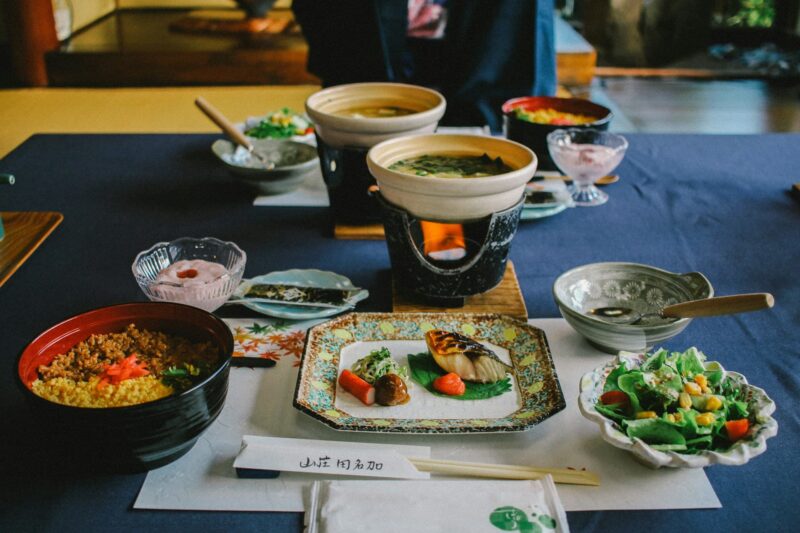Japanese cuisine, steeped in centuries-old traditions and shaped by its respect for nature and seasonality, is renowned worldwide for its balance, simplicity, and artistry. From the complex flavors of ramen to the vibrant colors of sushi, Japanese food celebrates fresh ingredients, thoughtful preparation, and harmony in every dish, offering a unique blend of taste, texture, and presentation that continues to captivate foodies around the globe.
In this guide, we’ll take you on a journey through the essential Japanese dishes enjoyed at breakfast, lunch, dinner, and dessert. Discover traditional flavors that make up daily life in Japan and indulge in sweets that bring a distinctive twist to the palate. Don’t forget to bookmark this guide before you travel — and if you’re ready to experience the best of Japanese food with your friends, start planning an unforgettable Japan trip with TourHero to savor every bite of this culinary paradise! 🍜🍣
Breakfast
Japanese breakfasts are crafted to be nourishing and balanced, offering a gentle start to the day with simple, comforting flavors. From the rich umami of miso soup to the protein-packed tamago kake gohan, each dish showcases the variety and appeal of Japanese food in the morning. These breakfast staples not only highlight Japan’s culinary roots but also introduce regional ingredients and flavors that vary with the seasons. Let’s dive into some must-try dishes that make Japanese food for breakfast so special.
Ochazuke
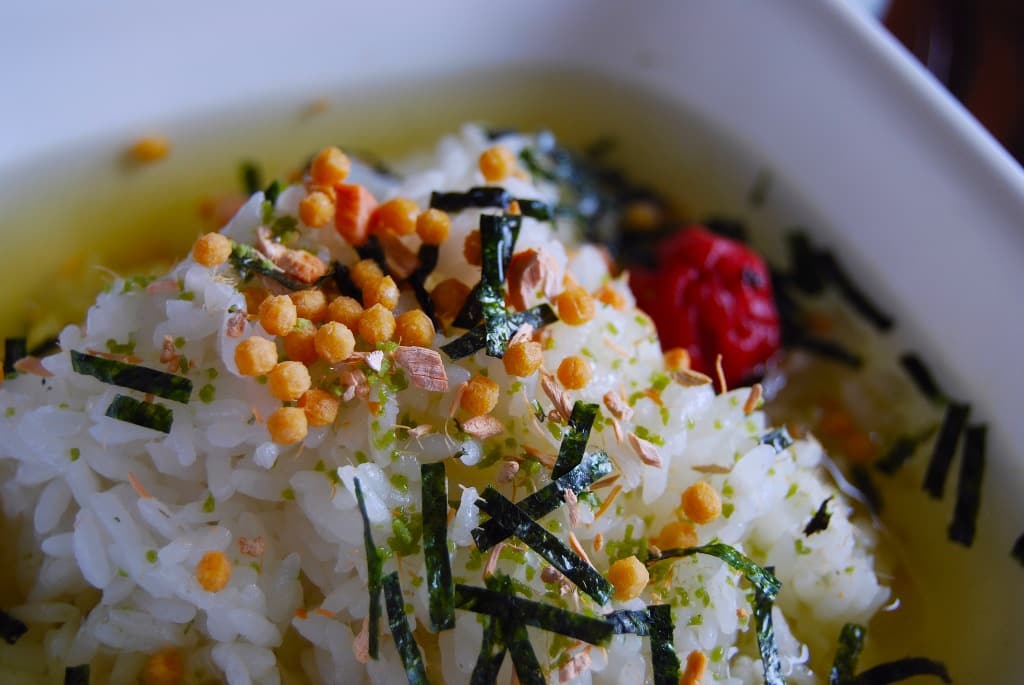
Ochazuke is a comforting, warm Japanese breakfast dish made by pouring tea, dashi, or hot water over steamed rice and various toppings. Common toppings include salted salmon, pickled plums, seaweed, and sesame seeds, creating a light yet flavorful dish that’s easy to prepare. Traditionally enjoyed as a simple and satisfying meal, ochazuke is loved for its versatility and soothing qualities, especially on cooler mornings.
🇯🇵 Variations of ochazuke
- Bubuzuke: A Kyoto-style ochazuke that traditionally uses a lighter green tea or a delicate dashi and regional Kyoto ingredients such as vegetable pickles and yuba (tofu skin).
- Salmon ochazuke: Popular in Hokkaido, where salmon is abundant. Topped with grilled or smoked salmon flakes, this version adds a savory, rich taste to the dish.
- Umeboshi ochazuke: A tart and refreshing version featuring pickled plum, popular in many parts of Japan.
💡 Interesting facts about ochazuke
- Ochazuke dates back to the Heian period, where it was originally served as a way to use leftover rice.
- The dish is a popular choice for people looking to enjoy a simple, soothing meal at home.
- Some restaurants specialize in ochazuke, offering a range of toppings and tea bases to personalize the experience.
🍽️ The proper way to eat ochazuke: Pour green tea or dashi over the rice and gently mix in the toppings. Enjoy each spoonful slowly, appreciating the warmth and simplicity of this comforting dish.
Miso soup
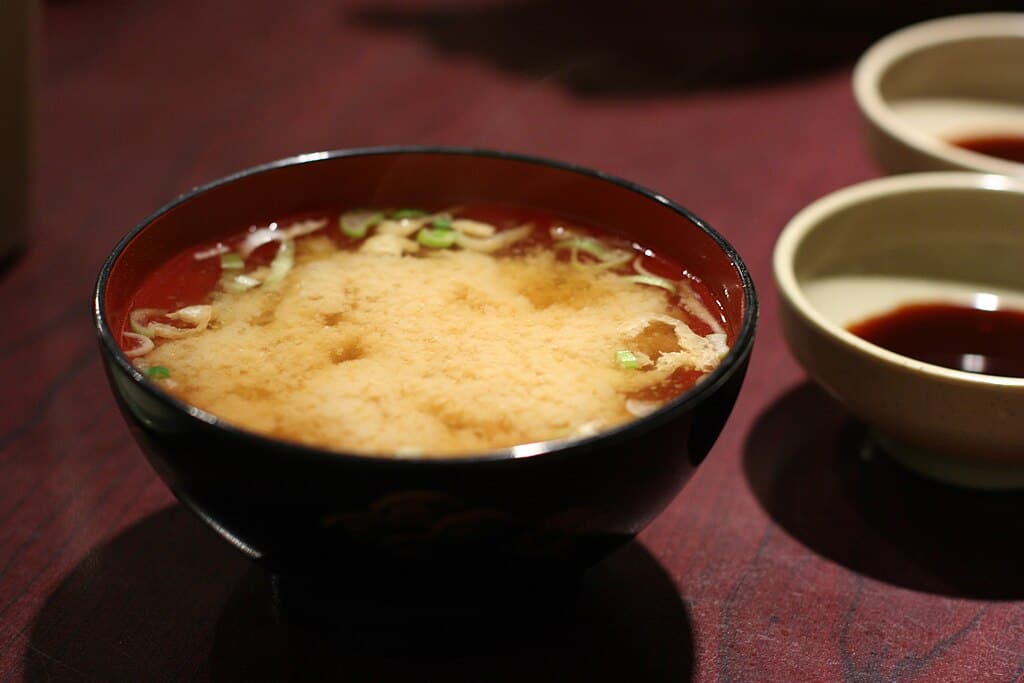
Miso soup is a cherished part of Japanese breakfast culture, known for its comforting, umami-rich flavors. Traditionally made with dashi, a stock of bonito flakes and seaweed, the soup gains depth when miso paste is added. Various regional ingredients such as tofu, seaweed, and seasonal vegetables enhance the flavor. Miso soup is a reflection of the seasons, with ingredients changing based on what’s fresh and available. Served alongside rice and pickled vegetables, it’s a warm, grounding way to start the day.
🇯🇵 Variations of miso soup
- Aka miso (red miso): A stronger, saltier version popular in central Japan.
- Shiro miso (white miso): Milder, sweeter miso common in western Japan.
- Awase miso: A blend of red and white miso, popular nationwide for a balanced flavor.
💡 Interesting facts about miso soup
- Miso’s origins trace back to ancient China, where a fermented soybean paste was used as early as 700 BCE.
- Some families in Japan create homemade miso that’s aged for several years.
- The fermentation process in miso produces beneficial probiotics, known to support gut health.
- Traditionally, miso soup is served at the end of meals in Kyoto to aid digestion.
🍽️ The proper way to eat miso soup: Hold the bowl close to your mouth and sip the soup directly, then use chopsticks to enjoy the tofu and seaweed. Savor each sip and bite, appreciating the harmony of umami flavors.
Tamago kake gohan
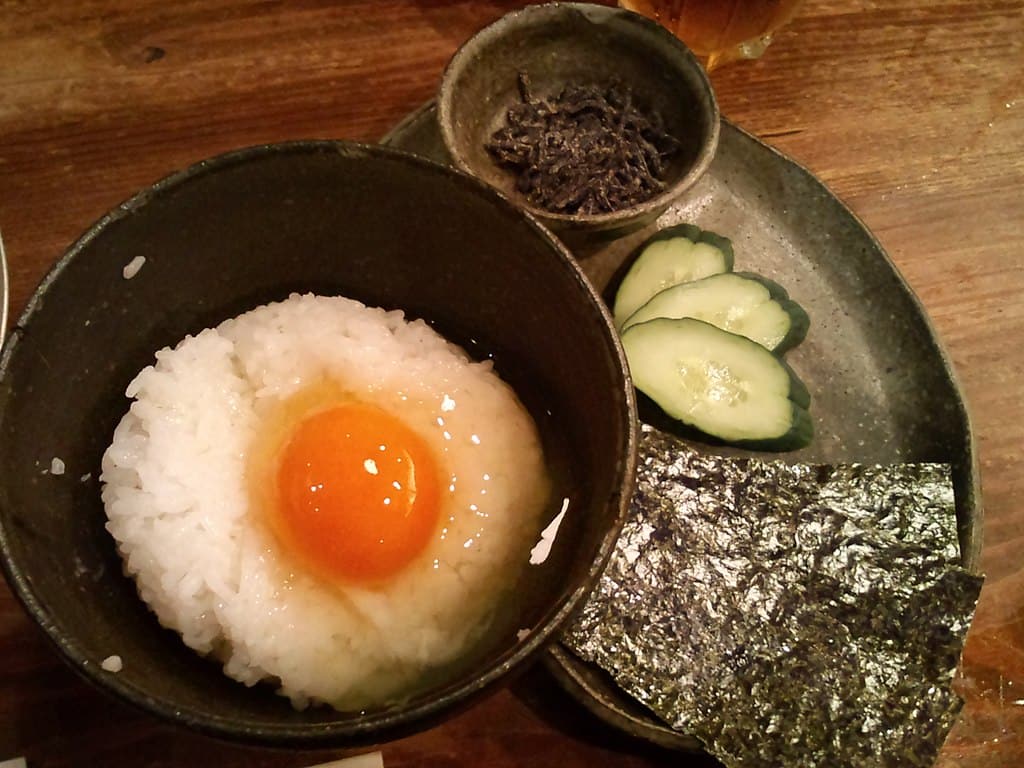
Tamago kake gohan, is a comforting Japanese breakfast of raw egg cracked over steaming hot rice. This dish has been enjoyed since the Edo period, combining rice, a core staple of Japanese cuisine, with egg’s protein and creamy texture. When soy sauce is added and the mixture is stirred, it creates a silky, slightly savory breakfast that is as nourishing as it is simple.
🇯🇵 Variations of tamago kake gohan
- Tamago shoyu tare: In some areas, the soy sauce is flavored with dashi for extra umami.
- Additions of pickled plums or seaweed: Some regions add extra toppings like umeboshi (pickled plum) or nori strips for a unique twist.
💡 Interesting facts about tamago kake gohan
- Tamago kake gohan was first popularized in the late 19th century when chickens became more widely domesticated in Japan.
- There are now special soy sauces in Japan made specifically for tamago kake gohan.
- Eating raw eggs in Japan is considered safe due to strict quality and freshness standards.
🍽️ The proper way to eat tamago kake gohan: Gently mix the egg and soy sauce into the rice until it’s evenly coated, then eat with chopsticks. The silky texture is meant to be enjoyed warm.
Natto
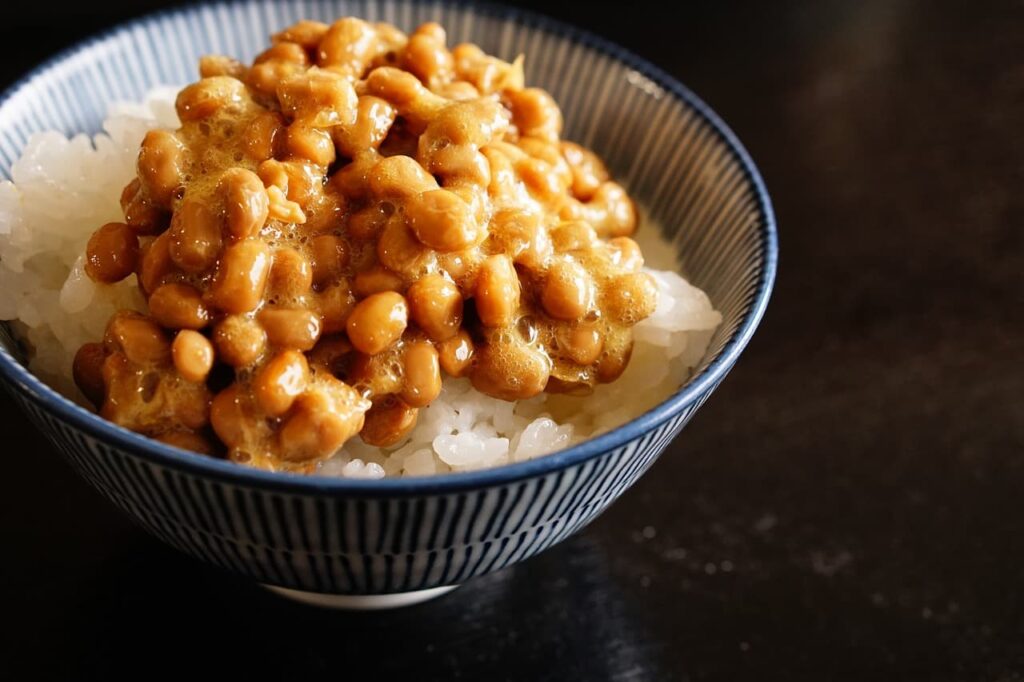
Natto is a traditional Japanese breakfast food made from fermented soybeans, known for its strong flavor, sticky texture, and pungent aroma. Often served over steamed rice, natto is a high-protein, probiotic-rich dish that’s as nutritious as it is unique. Although polarizing for some due to its taste and texture, natto remains a staple in many Japanese households.
🇯🇵 Variations of natto
- Hikiwari natto: Finely chopped natto, easier to mix and commonly found in eastern Japan.
- Okinawan matto: Known for being less sticky and having a milder flavor compared to traditional Japanese natto.
💡 Interesting facts about natto
- Natto is believed to have been discovered by accident over 1,000 years ago.
- It’s known for its health benefits, especially for gut health and heart health.
- Natto is often paired with mustard, soy sauce, and green onions for added flavor.
🍽️ The proper way to eat natto: Stir natto vigorously to enhance its stickiness, then mix with soy sauce and green onions before pouring it over rice. Enjoy it slowly to appreciate its unique taste and texture.
Onigiri
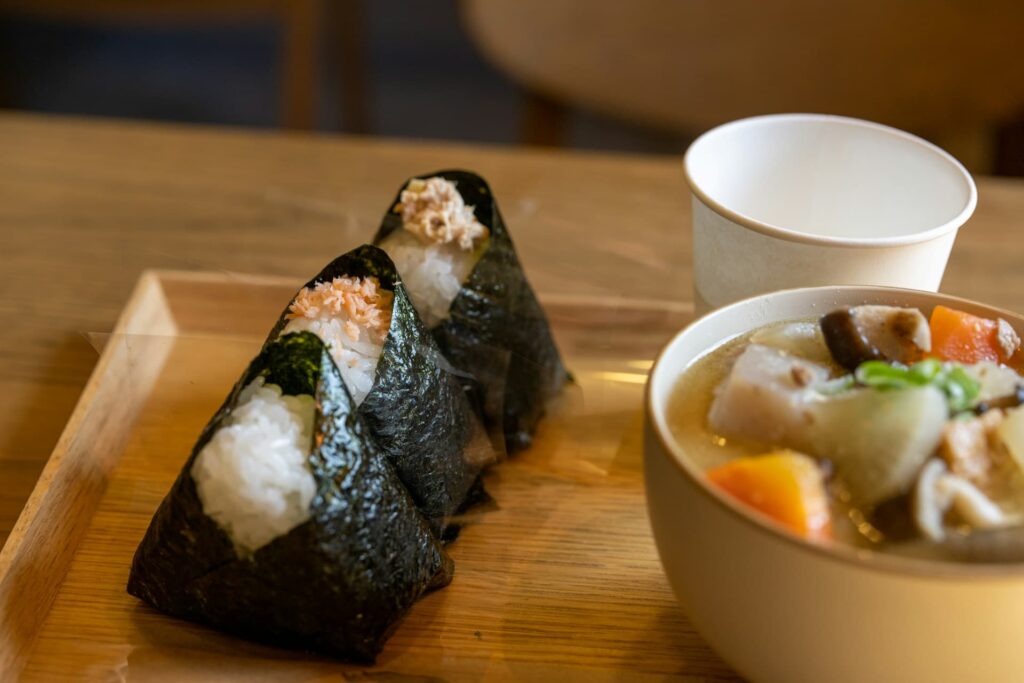
Onigiri, or rice balls, are a classic Japanese breakfast and snack item, often enjoyed for their portability and versatility. Made from lightly salted rice and filled with ingredients like salmon, pickled plum, or tuna mayo, onigiri is wrapped in nori and shaped into triangles or rounds. It’s a simple, flavorful breakfast option perfect for eating on the go.
🇯🇵 Variations of onigiri
- Shio musubi: A plain, salted rice ball with no filling, often wrapped partially in nori. One of the most traditional types of onigiri.
- Mentaiko onigiri: Filled with spicy cod roe, commonly enjoyed in Kyushu.
- Okaka onigiri: Filled with katsuobushi (bonito flakes) for a deep, savory flavor.
- Yaki onigiri: Grilled with a brush of soy sauce or miso, giving the rice a crispy, caramelized exterior. Popular at izakayas (Japanese pubs).
💡 Interesting facts about onigiri
- First mentioned in historical texts from the Heian Period (794 – 1185).
- Traditionally, before refrigeration, they were stored in bamboo leaves to keep them fresh.
- Some regions use various shapes for different fillings, making it easy to identify what’s inside.
🍽️ The proper way to eat onigiri: Hold the onigiri by the nori-wrapped section and take bites, enjoying the contrast between the soft rice and flavorful filling. Dip in soy sauce if desired.
Lunch
Lunchtime in Japan is often hearty and fulfilling, designed to provide energy for the rest of the day. Japanese lunch dishes, from iconic bowls of ramen to delicate tempura, demonstrate the diversity within Japanese food. Lunch offers a chance to explore Japan’s culinary landscape with options perfect for a quick meal or a leisurely break. Here are some classic Japanese food options you’ll want to try for lunch.
Oyakodon
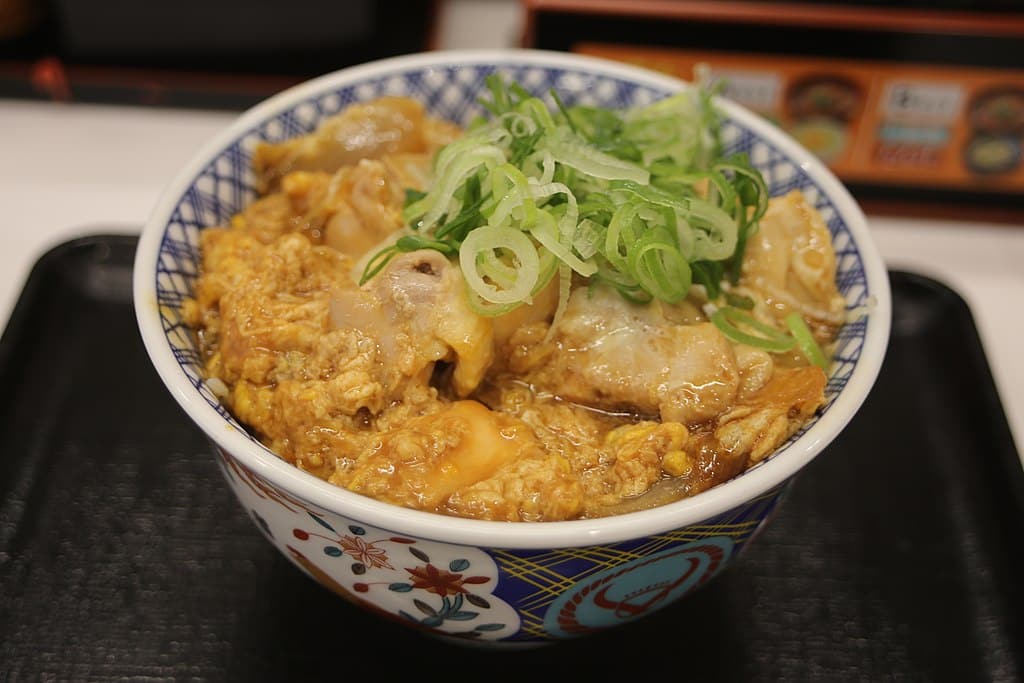
Oyakodon, translating to “parent and child bowl,” is a popular and hearty Japanese lunch dish featuring simmered chicken and egg over rice. The chicken and onions are cooked in a savory dashi-based broth, then a beaten egg is poured over and allowed to set lightly. This comforting dish is enjoyed for its blend of textures and flavors, with the soft egg and tender chicken complementing the rice perfectly.
🇯🇵 Variations of oyakodon
- Kansai-style oyakodon: Uses a slightly sweeter broth for added flavor.
- Oyako nabe: A hot pot version where ingredients are cooked together in a single pot and served family-style.
- Salmon oyakodon: Found in northern Japan, this version replaces chicken with salmon and ikura (salmon roe), giving it a seafood twist.
💡 Interesting facts about oyakodon
- The name “oyakodon” reflects the ingredients of chicken and egg, symbolizing “parent and child.”
- It’s one of Japan’s most popular donburi (rice bowl) dishes, loved for its ease and nutrition.
- The dish is traditionally cooked in a small, single-serving pan called an “oyako nabe.”
🍽️ The proper way to eat oyakodon: Use chopsticks or a spoon to combine each bite of rice, chicken, and egg for a balanced mouthful. Enjoy with pickles or miso soup for an even more satisfying meal.
Tonkatsu
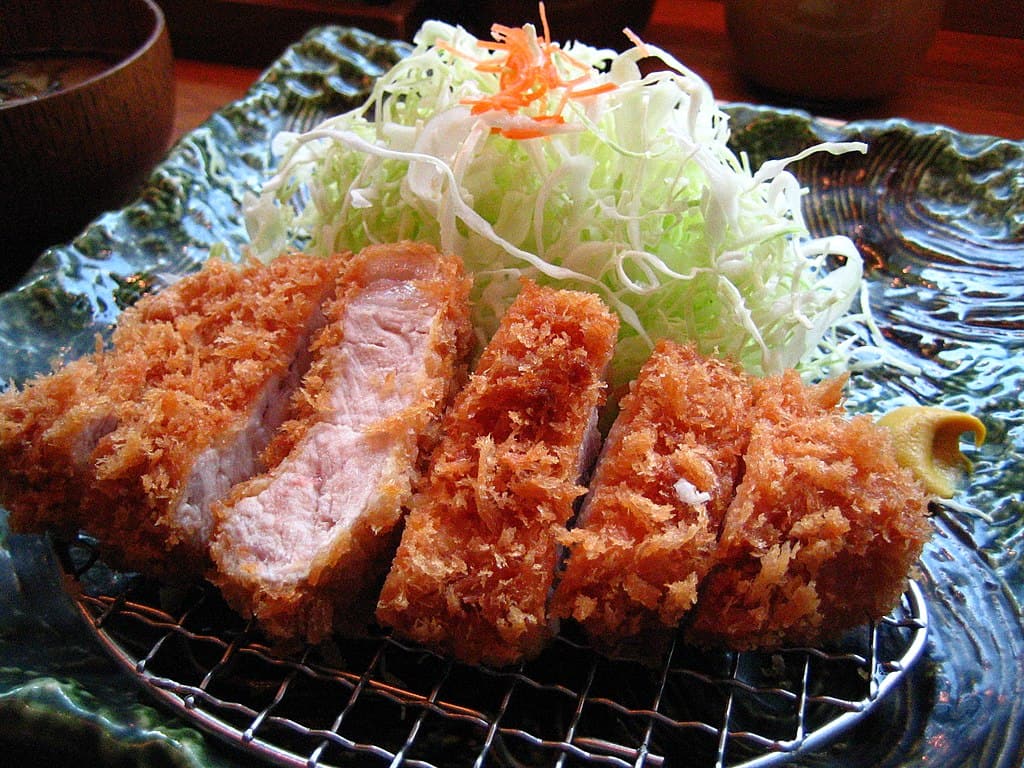
Tonkatsu is a Japanese pork cutlet breaded in panko (Japanese breadcrumbs) and fried until golden and crispy. Served with shredded cabbage, rice, and a tangy, sweet sauce, tonkatsu is both satisfying and flavorful, making it a popular lunch choice. Some restaurants even specialize in tonkatsu, offering various cuts of pork to enhance texture and flavor.
🇯🇵 Variations of tonkatsu
- Katsu sando: Tonkatsu served in a sandwich, popular as a quick meal.
- Miso katsu: Topped with a rich miso sauce, common in Nagoya.
- Menchi katsu: Ground pork or beef, breaded and fried, often found in bento boxes.
💡 Interesting facts about tonkatsu
- Tonkatsu was inspired by European breaded cutlets and first introduced in the 19th century.
- Katsu sauce is similar to Worcestershire sauce but thicker and sweeter.
- Some restaurants let you grind your own sesame seeds to mix into the sauce.
🍽️ The proper way to eat tonkatsu: Slice the cutlet into bite-sized pieces, dip in sauce, and enjoy with rice and cabbage. The crispy coating and tender pork create a delightful contrast in each bite.
Tempura
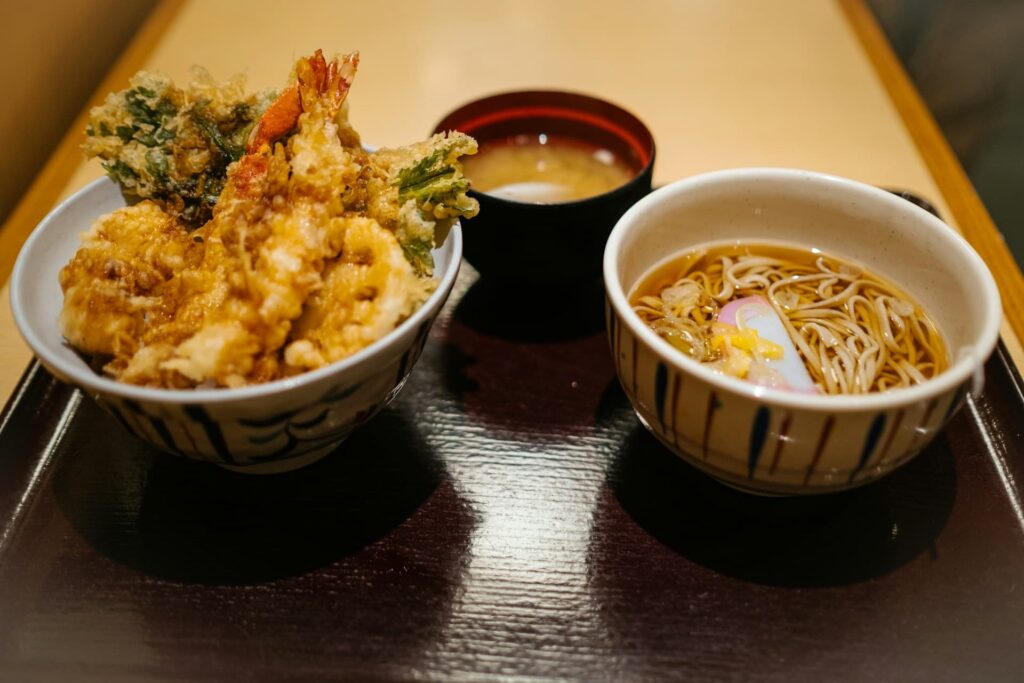
Tempura is a popular Japanese dish featuring seafood or vegetables lightly battered and deep-fried to a golden crisp. Introduced to Japan by Portuguese missionaries in the 16th century, tempura has become a well-loved lunch option for its light texture and delicate flavor. It’s typically served with a dipping sauce made from dashi, soy sauce, and grated daikon radish.
🇯🇵 Variations of tempura
- Ebi tempura: Made with shrimp, a classic and popular choice.
- Vegetable tempura: Seasonal vegetables such as sweet potato, kabocha squash, and mushrooms.
- Anago tempura: Saltwater eel, often enjoyed in regions near the sea.
💡 Interesting facts about tempura
- Tempura was one of the first Western-influenced dishes to become popular in Japan.
- It’s traditionally fried in sesame oil, which adds a unique flavor.
- In Japan, tempura batter is made with cold water to ensure crispiness.
- Tempura is usually enjoyed on its own or as a topping for rice or udon.
🍽️ The proper way to eat tempura: Dip each piece lightly in the sauce to avoid overwhelming the delicate flavor. Eat each bite fresh for the ultimate crispy texture.
Ramen
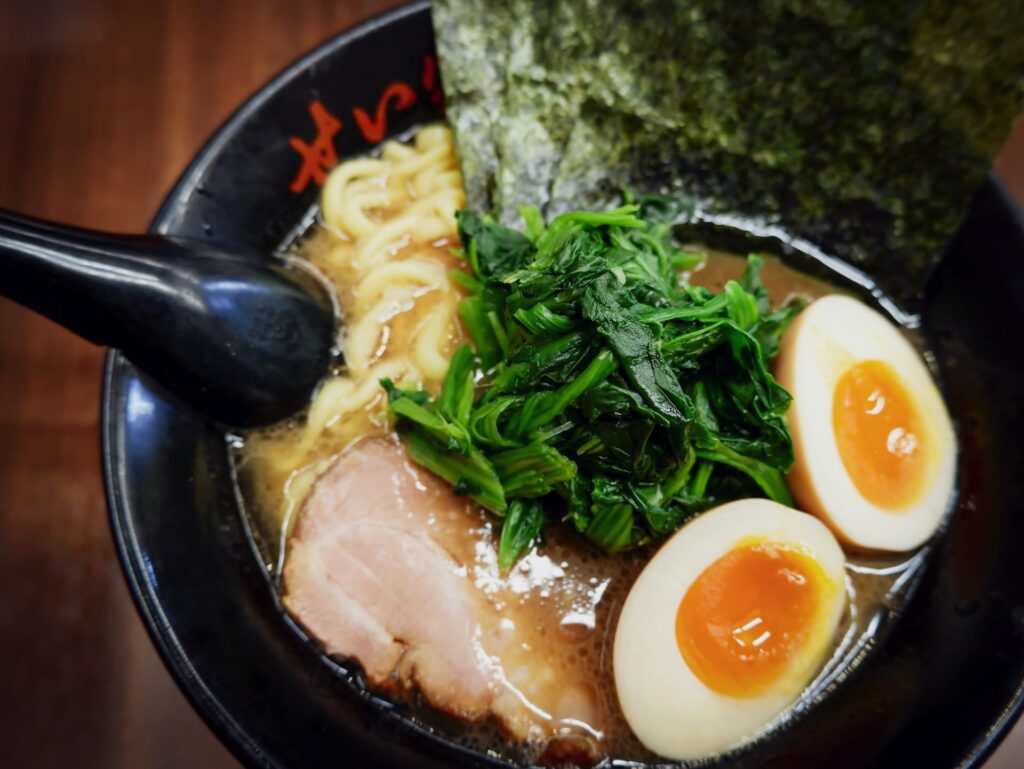
Ramen, a Japanese culinary icon, originated from Chinese noodle soup and has evolved into a diverse dish deeply rooted in Japanese food culture. Ramen broth can vary by region and is crafted with meticulous attention to detail, whether it’s shoyu (soy sauce-based), miso, or tonkotsu (pork bone). Each bowl is topped with pork, scallions, nori, and a seasoned egg. In Japan, ramen is more than a dish — it’s an experience savored with anticipation and enjoyed with slurps.
🇯🇵 Variations of ramen
- Sapporo ramen: Rich miso broth topped with sweet corn and a pat of melting butter.
- Hakata ramen: Tonkotsu (pork bone) broth, creamy and rich. Often garnished with green onions, pickled ginger, and sometimes garlic or spicy red sauce.
- Tokyo ramen: Shoyu (soy sauce) broth with a light, clear flavor.
💡 Interesting facts about ramen
- Ramen was introduced to Japan from China in the late 1800s.
- Making the “slurping” sound when eating ramen enhances flavor perception and is encouraged.
- Ramen shops often have a vending machine system for ordering to keep the process efficient.
- A typical bowl of ramen can take up to 8 hours (or more) to prepare due to the complex broth.
🍽️ The proper way to eat ramen: Use chopsticks to lift the noodles and slurp them, a practice that enhances the flavor and cools the noodles. Drink the broth directly from the bowl to enjoy its rich taste.
Okonomiyaki
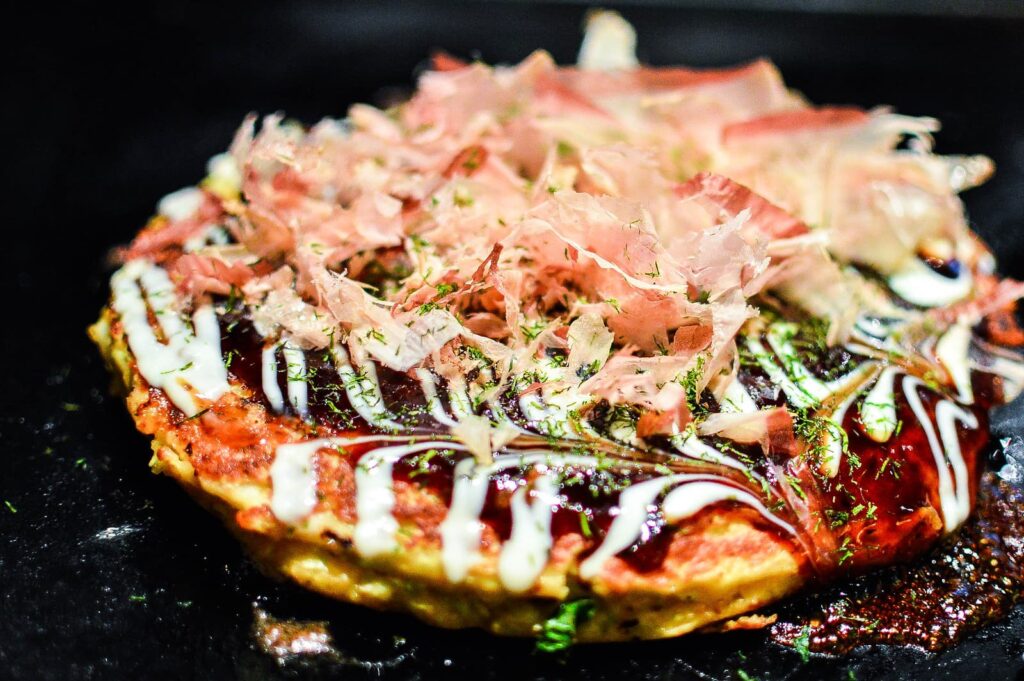
Okonomiyaki, often referred to as “Japanese savory pancake,” is a popular and beloved dish originating from Osaka. Made from a batter of flour, grated yam, and eggs, it’s mixed with shredded cabbage and other ingredients such as pork, seafood, or cheese. This mixture is then grilled to perfection and topped with okonomiyaki sauce, Japanese mayonnaise, bonito flakes, and seaweed powder. Known for its rich, savory flavor and satisfying texture, okonomiyaki is a staple of Osaka street food culture and is enjoyed at specialty restaurants or made at home.
🇯🇵 Variations of okonomiyaki
- Osaka-style okonomiyaki: Ingredients are mixed into the batter before grilling, creating a cohesive pancake-like texture.
- Hiroshima-style okonomiyaki: Layered with noodles (usually yakisoba or udon) and cooked in distinct layers rather than mixed.
- Modern okonomiyaki: Often topped with extra items like cheese, mochi, or kimchi for additional flavors.
💡 Interesting facts about okonomiyaki
- The name “okonomiyaki” translates to “grilled as you like it,” reflecting the customizability of the dish.
- Okonomiyaki is often cooked at the table on a teppan (iron griddle) in many Osaka restaurants, allowing diners to make it to their taste.
- It’s common to serve okonomiyaki with aonori (seaweed flakes) and katsuobushi (bonito flakes) that dance from the heat of the pancake.
🍽️ The proper way to eat okonomiyaki: Cut the okonomiyaki into small squares with a spatula, then enjoy each bite with a mix of sauce, mayo, and toppings. Pair with a cold drink to balance the richness of the dish.
Dinner
Japanese dinner is traditionally a time for family and friends to gather and enjoy dishes that emphasize seasonality and freshness, a hallmark of Japanese food. The flavors deepen, with popular dinner options like sushi and sukiyaki showcasing the skill and care in Japanese cooking. Whether dining out or enjoying a home-cooked meal, Japanese food for dinner is about savoring every bite. Let’s explore some staple dishes that capture the essence of Japanese food for the evening.
Sukiyaki
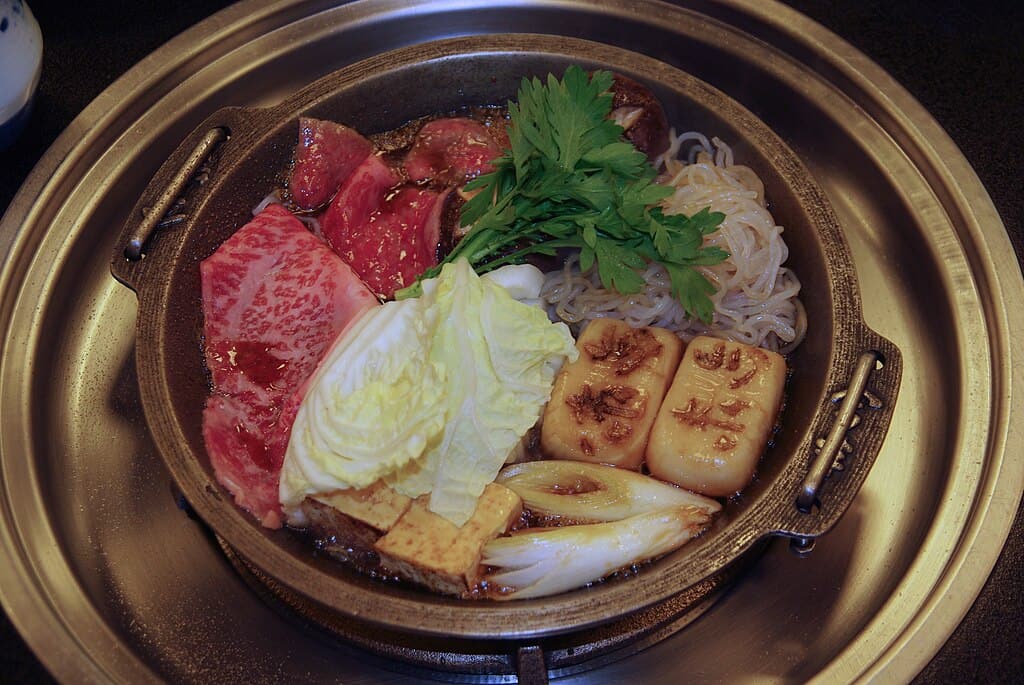
Sukiyaki is a cherished Japanese hot pot dish, enjoyed especially in the winter. Thin slices of beef are simmered with tofu, mushrooms, and vegetables in a soy-based sweet broth. Sukiyaki is a communal meal and a social dining experience, often enjoyed by friends and family around a simmering pot. Ingredients are traditionally dipped in a raw egg before eating, adding richness and balancing the dish’s sweetness.
🇯🇵 Variations of sukiyaki
- Kanto-style sukiyaki: Ingredients are cooked in the broth from the beginning.
- Kansai-style sukiyaki: Ingredients are grilled first, then broth is added gradually.
- Chicken sukiyaki: Uses chicken instead of beef, common in some regions.
💡 Interesting facts about sukiyaki
- Sukiyaki was popularized during the Meiji period when beef became widely accepted in Japan.
- It’s often served on special occasions, as it’s considered a luxurious meal.
- Eating sukiyaki with raw egg adds a creamy, rich texture.
- Sukiyaki is typically served at home or in specialty hot pot restaurants.
🍽️ The proper way to eat sukiyaki: Dip each cooked item in raw beaten egg for a richer flavor, then eat with chopsticks. Savor the sweetness of the broth combined with the tender beef.
Yakitori
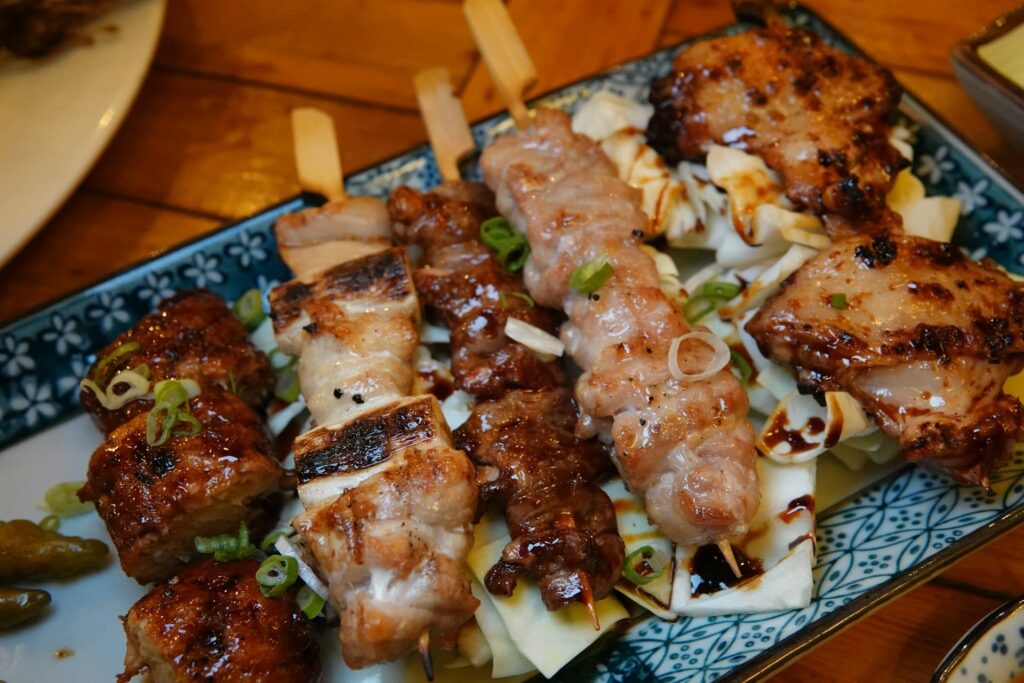
Yakitori, a centuries-old favorite in Japanese food culture, has become a staple at izakayas and evening street stalls, celebrated for its flavorful simplicity. This skewered, grilled chicken is seasoned with either salt or tare (soy-based sauce), with each skewer — from tender thigh meat to rich chicken liver — showcasing a unique flavor and texture. Loved by locals and tourists alike, yakitori offers a taste of Japan’s casual dining scene at its best.
🇯🇵 Variations of yakitori
- Negima yakitori: Chicken thigh and scallion skewers.
- Tsukune: Chicken meatball skewers with a sweet glaze.
- Reba yakitori: Chicken liver skewers, often enjoyed with tare sauce.
💡 Interesting facts about yakitori
- Yakitori is traditionally cooked over binchotan charcoal, which enhances flavor.
- In Japan, “yakitori-ya” are specialty shops dedicated to skewers.
- Izakayas often serve yakitori with beer or sake.
- Skewers are also made with vegetables, tofu, and other meats.
🍽️ The proper way to eat yakitori: Hold the skewer and eat each piece directly from it, or remove the meat with chopsticks if sharing. Enjoy with a sip of sake or beer to enhance the flavors.
Sushi
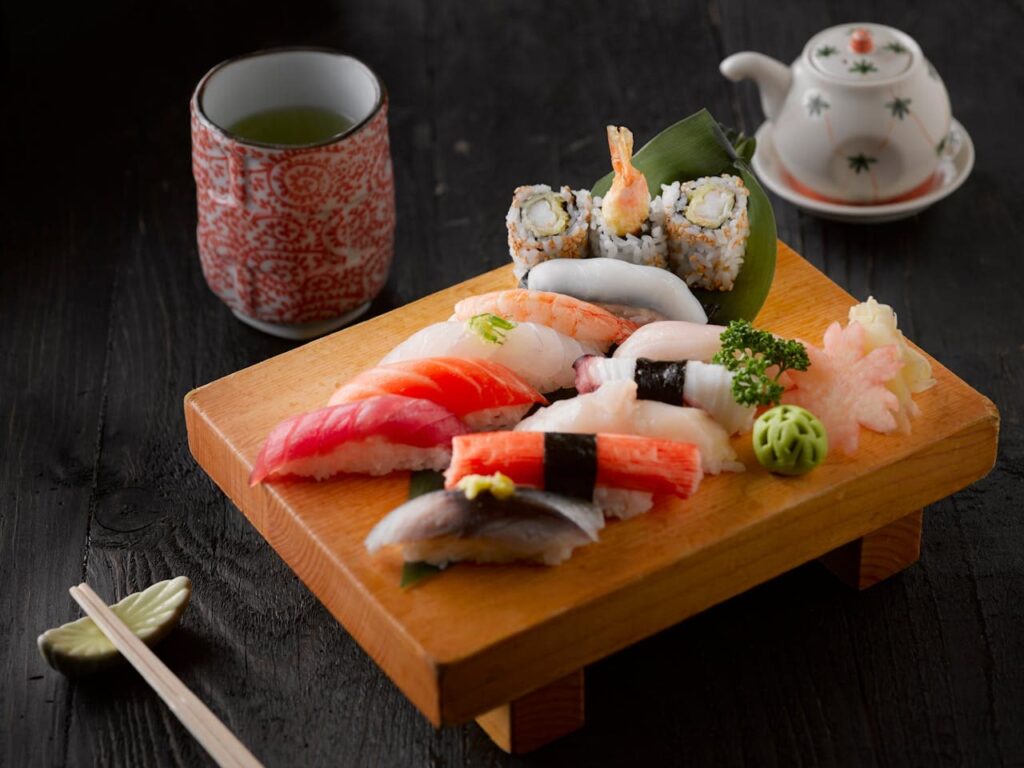
It’s impossible to talk about Japanese food without mentioning sushi. Sushi is a renowned favorite that began as a way to preserve fish through fermentation. Today, it’s a culinary art form where vinegared rice is paired with fresh seafood, vegetables, and even delicate toppings like caviar. Nigiri sushi and maki rolls are among the most popular types, and the delicate balance of flavors and textures requires top-quality ingredients. Sushi dining is highly regarded in Japan, often enjoyed in omakase style, where the chef selects the best seasonal fish for each bite.
🇯🇵 Variations of sushi
- Osaka-style sushi: Square, pressed sushi known as “oshizushi.”
- Chirashi sushi: Meaning “scattered sushi,” rice is topped with various sashimi ingredients to create a vibrant dish.
- Inari sushi: Vinegared rice tucked inside a tender, sweet-savory pocket of fried tofu.
💡 Interesting facts about sushi
- Sushi chefs in Japan train for over a decade to perfect their technique.
- Japanese etiquette encourages eating sushi in one bite.
- Sushi rice is seasoned with vinegar, sugar, and salt, but each chef’s blend is unique.
🍽️ The proper way to eat sushi: Dip the fish side — not the rice — in soy sauce to avoid overpowering the flavor. Eat each piece in one bite, savoring the fresh taste of the fish and rice.
Nikujaga
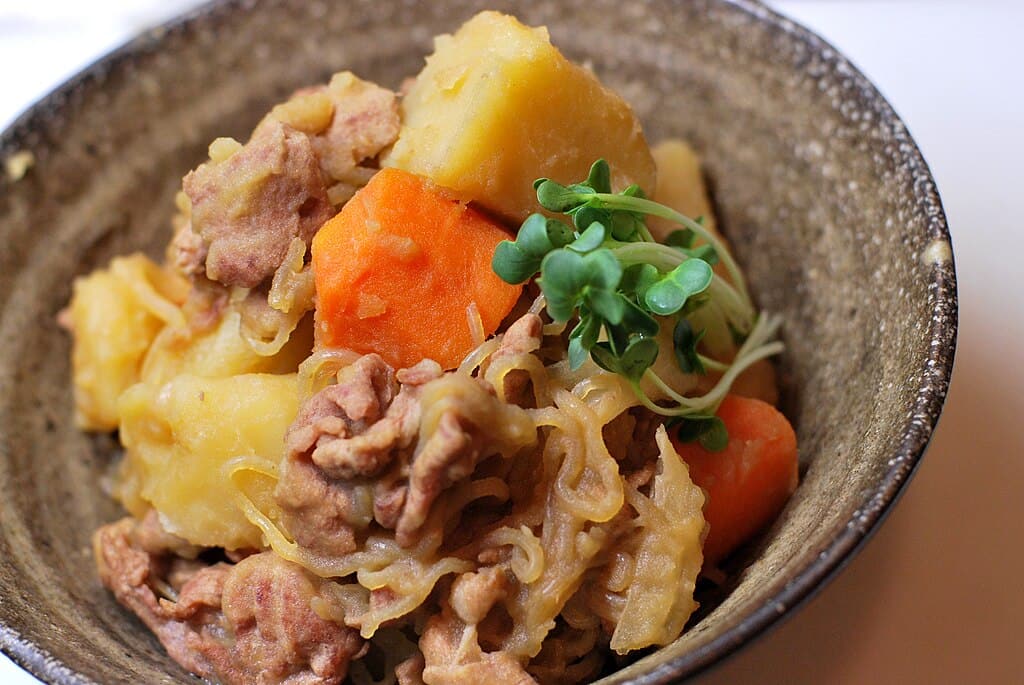
Nikujaga is a hearty and comforting Japanese food dish often enjoyed as a filling dinner option, especially during colder months. This stew combines thinly sliced beef (or pork) with potatoes, onions, and carrots, all simmered in a slightly sweet soy sauce and dashi broth. The potatoes absorb the savory broth, creating a rich and flavorful meal that’s both simple and deeply satisfying. Often considered Japanese home-cooked comfort food, nikujaga showcases the flavors of traditional Japanese cooking while providing warmth and nourishment.
🇯🇵 Variations of nikujaga
- Kansai-style nikujaga: Commonly uses pork instead of beef, reflecting regional preferences.
- Vegetable-heavy nikujaga: Some regions add more vegetables, like green beans or mushrooms, for added depth and flavor.
- Nikujaga with noodles: Some variations incorporate udon or shirataki noodles (made from konjac) to make the dish more filling.
💡 Interesting facts about nikujaga
- Nikujaga was inspired by Western beef stews but adapted to Japanese tastes and ingredients.
- It’s often cooked in large batches and reheated, as the flavors deepen over time.
- Nikujaga is known as a quintessential “mother’s cooking” dish in Japan, often bringing nostalgia.
🍽️ The proper way to eat nikujaga: Use chopsticks to enjoy each bite, ensuring you get a bit of meat, potato, and broth together. Pair with rice and miso soup for a complete and satisfying meal.
Gyu don
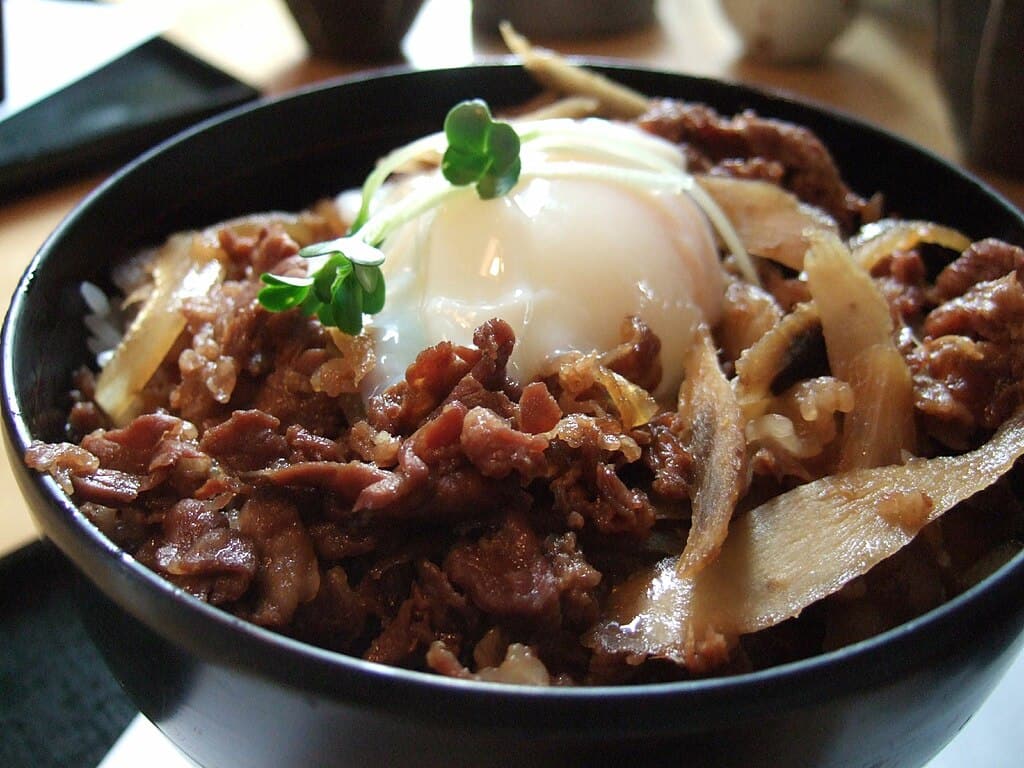
Gyu don, or beef bowl, is a staple Japanese dinner option that combines thinly sliced beef and onions simmered in a savory-sweet broth of dashi, soy sauce, and mirin. Served over steamed rice, the broth infuses the beef and onions with deep, comforting flavors. Gyu don is a quick and easy meal yet incredibly satisfying, with the rice soaking up the flavorful sauce and making each bite rich and fulfilling.
🇯🇵 Variations of gyu don
- Kansai-style gyu don: Often includes additional ingredients like grated ginger and garlic for extra depth.
- Egg-topped gyu don: A raw or soft-boiled egg is cracked over the bowl, creating a creamy texture.
- Kimchi gyu don: Increasingly popular in Japan, a side of kimchi is added to complement the savory beef with a spicy kick.
💡 Interesting facts about gyu don
- Gyu don is one of Japan’s most popular fast-food dishes, widely available in Japanese chains.
- The dish is typically made with thinly sliced sukiyaki beef, which absorbs flavors quickly.
- It’s common to add beni shoga (pickled ginger) as a garnish to enhance the flavor.
🍽️ The proper way to eat gyu don: Mix in the egg if included, then use chopsticks or a spoon to enjoy each bite with both beef and rice. Garnish with pickled ginger or green onions for added flavor.
Dessert
Japanese desserts are as beautiful as they are delicious, often featuring subtle flavors and elegant presentations. From the chewy texture of mochi to the refreshing coolness of kakigori, Japanese desserts bring unique twists to the table. These desserts are typically light, making them a perfect way to end a meal or enjoy as a treat any time of day. Here are some delightful Japanese foods to try at the dessert table the next time you’re in Japan!
Anmitsu
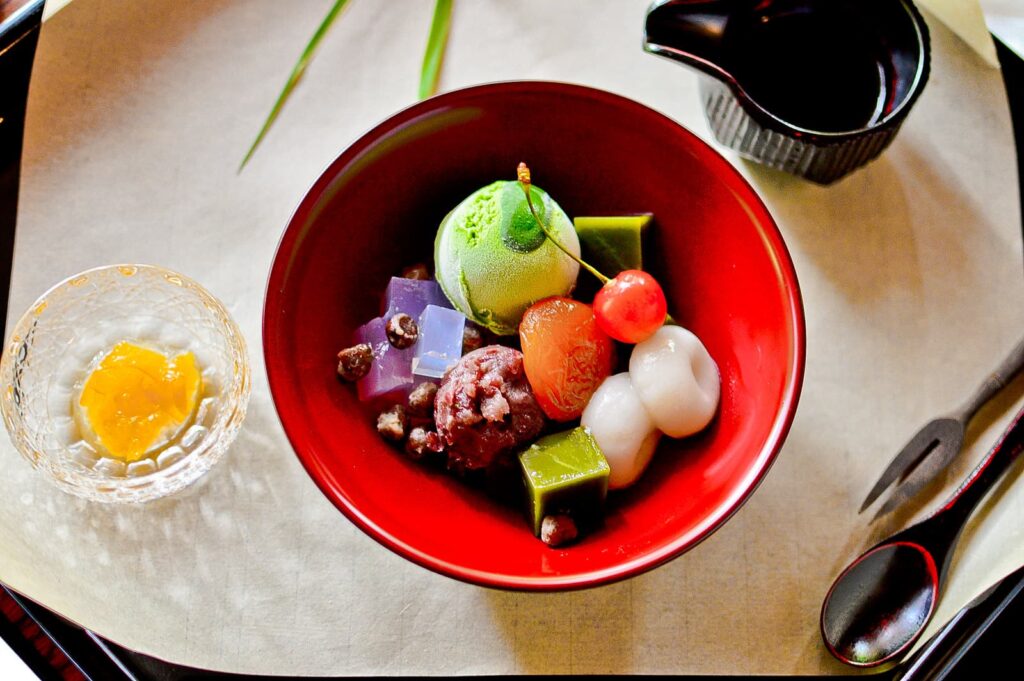
Anmitsu is a traditional Japanese dessert made from small cubes of agar jelly, often served with azuki red beans, fresh fruit, and a sweet kuromitsu syrup. This refreshing dessert is a favorite in summer, loved for its light, refreshing flavors and beautiful presentation.
🇯🇵 Variations of anmitsu
- Mitsumame: Similar to anmitsu but made without the red bean paste.
- Cream anmitsu: Served with a scoop of ice cream on top for added creaminess.
- Matcha anmitsu: Agar jelly flavored with matcha for a green tea twist.
💡 Interesting facts about anmitsu
- Anmitsu dates back to the Meiji era and is traditionally served in cafes and dessert shops.
- Kuromitsu, a dark sugar syrup, adds a unique depth of sweetness to anmitsu.
- The use of agar jelly makes it a low-calorie, vegetarian-friendly dessert.
🍽️ The proper way to eat anmitsu: Drizzle the kuromitsu over the jelly, fruit, and red beans. Use a spoon to mix slightly and enjoy a combination of flavors in each refreshing bite.
Kakigori
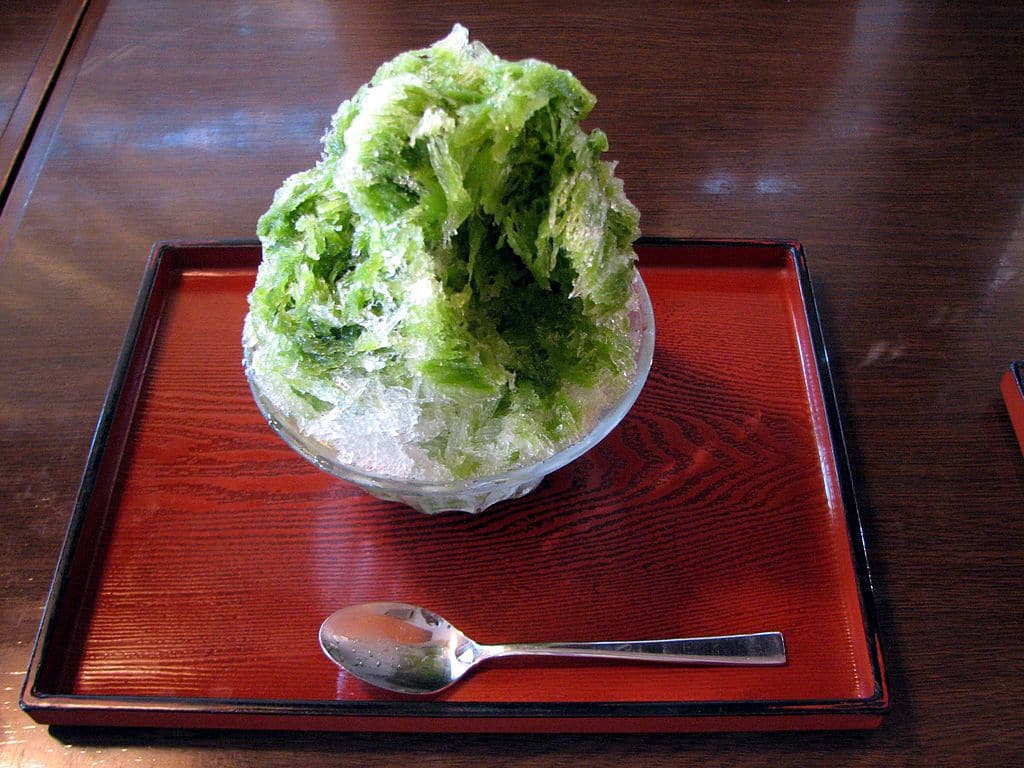
Kakigori is a popular Japanese summer dessert made from finely shaved ice topped with flavored syrups like matcha, strawberry, or melon. This refreshing treat is often served with condensed milk for extra creaminess and sometimes paired with toppings like azuki red beans or mochi. Kakigori is known for its fluffy, snow-like texture that melts in the mouth, providing a cool, sweet escape from the heat.
🇯🇵 Variations of kakigori
- Ujikintoki kakigori: Topped with matcha syrup, azuki beans, and sometimes mochi, common in Kyoto.
- Shirokuma kakigori: Originating in Kagoshima, this version includes fruit and condensed milk for a colorful presentation.
💡 Interesting facts about kakigori
- Kakigori dates back to the Heian period, where it was an exclusive treat for the noble class.
- Traditional kakigori is made using hand-cranked ice shavers for an ultra-fine texture.
- Modern versions sometimes include unique flavors like yuzu, sakura, and even savory miso.
🍽️ The proper way to eat kakigori: Use a spoon to scoop the fluffy ice, letting it melt on your tongue for a refreshing experience. For added creaminess, pour extra condensed milk or mix the syrup for balanced flavor.
Yokan
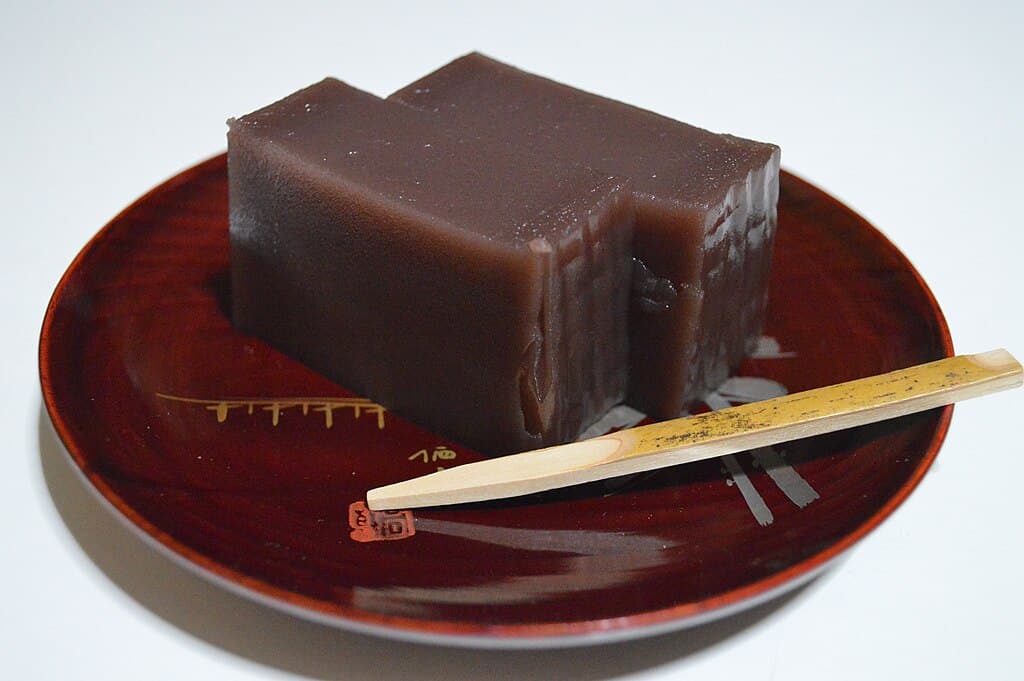
Yokan is a traditional Japanese dessert made from azuki red bean paste, sugar, and agar (a natural gelling agent derived from seaweed). This dense, smooth jelly has been a staple of Japanese food since the Edo period, known for its subtly sweet flavor and firm texture. Yokan is typically enjoyed in small slices with a cup of green tea, allowing the delicate sweetness to balance the tea’s earthy bitterness.
🇯🇵 Variations of yokan
- Mizu yokan: A softer, lighter version often served chilled in summer.
- Chestnut yokan: Adds pieces of chestnut for an autumnal flavor and texture.
- Matcha yokan: Infused with green tea powder for a hint of earthy, bittersweet flavor.
💡 Interesting facts about yokan
- Yokan was originally introduced to Japan by Chinese monks and adapted over centuries.
- Traditional yokan is made with kanten (Japanese agar), making it a vegetarian-friendly dessert.
- It’s considered an ideal accompaniment for tea ceremonies due to its refined taste and presentation.
🍽️ The proper way to eat yokan: Slice the yokan into small pieces, enjoying each bite slowly to savor its dense texture and mild sweetness. Pair it with green tea for a classic Japanese dessert experience.
Warabi mochi
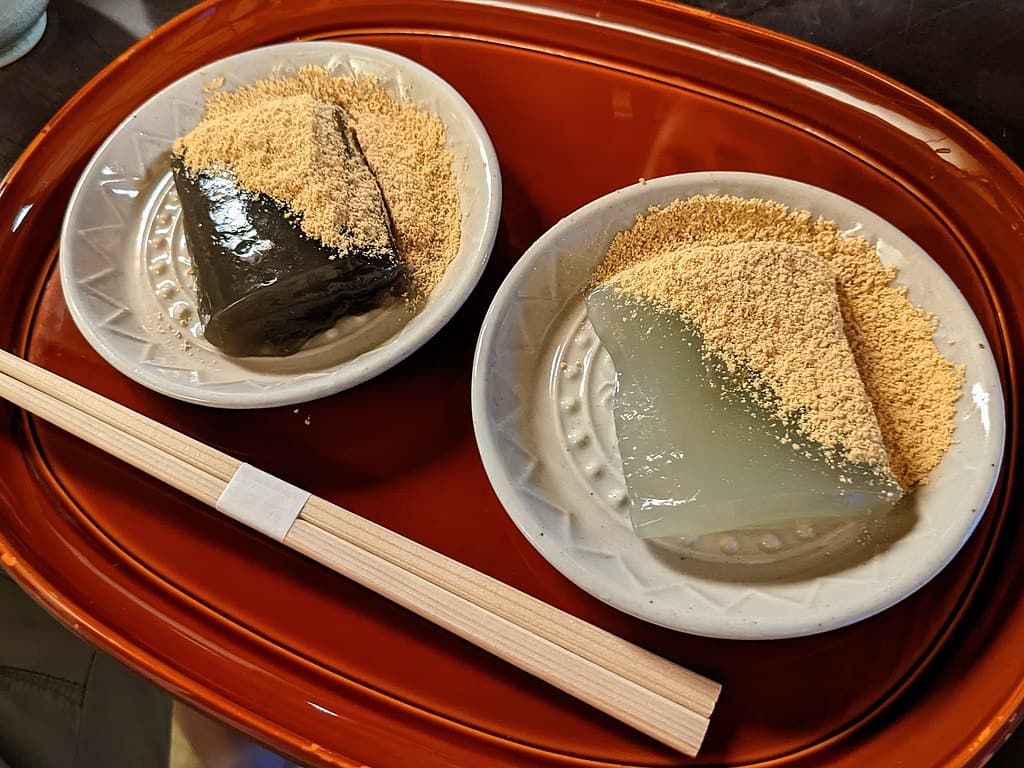
Warabi mochi is a delicate, jelly-like dessert made from warabi starch (bracken starch) and often coated in kinako (roasted soybean flour). Originating in Kyoto, this cool and refreshing Japanese food has become a popular summer treat, loved for its smooth, melt-in-your-mouth texture and subtle, earthy flavor. Warabi mochi’s light, chewy texture makes it an ideal dessert to enjoy on hot days!
🇯🇵 Variations of warabi mochi
- Kudzu mochi: Made with kudzu starch instead of warabi, common in regions where kudzu is grown.
- Green tea warabi mochi: Flavored with matcha powder instead of kinako, adding a hint of bitterness and a vibrant color.
- Kuromitsu warabi mochi: Drizzled with kuromitsu (black sugar syrup) for a richer, sweeter taste.
💡 Interesting facts about warabi mochi
- Warabi mochi’s texture is much softer than regular mochi, as it uses starch rather than glutinous rice.
- Traditionally, warabi mochi was considered a luxurious treat due to the rarity of bracken starch.
- It’s commonly sold at summer festivals and markets throughout Japan as a refreshing snack.
🍽️ The proper way to eat warabi mochi: Dip each piece in kinako or drizzle with kuromitsu if available. Use chopsticks to pick up each bite, enjoying the light, jelly-like texture that melts in your mouth.
Daifuku mochi
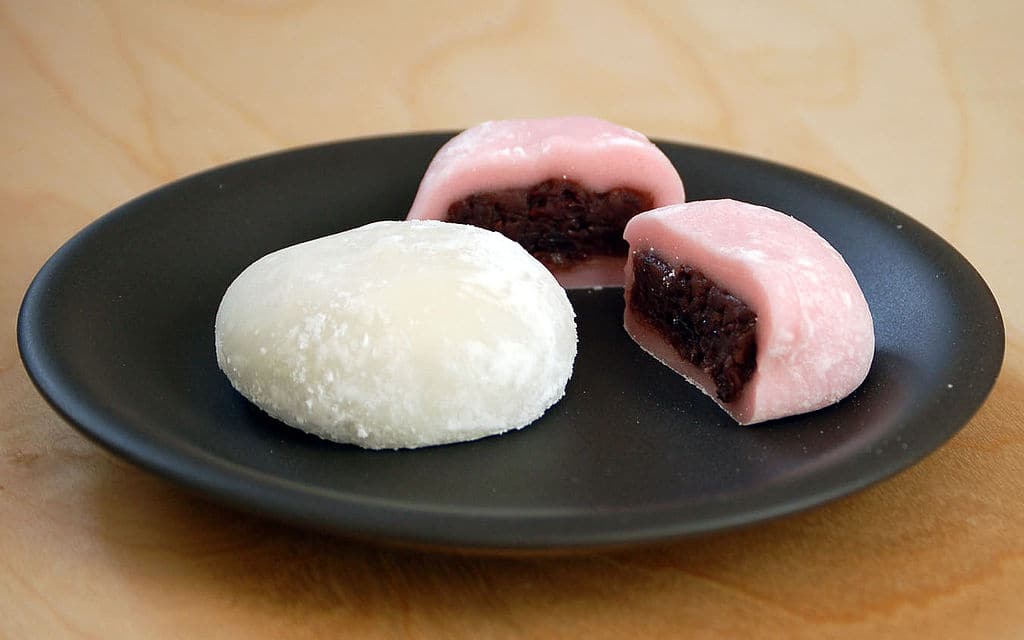
Daifuku mochi is a beloved Japanese confection made from soft, chewy mochi (glutinous rice dough) filled with a sweet filling, typically azuki red bean paste. The name “daifuku” means “great luck”, symbolizing prosperity and good fortune. This round, pillowy treat comes in various flavors and fillings, with each bite offering a delightful contrast between the tender mochi exterior and the smooth, sweet filling inside. Daifuku mochi is enjoyed year-round and often given as a thoughtful gift, cherished for its simple yet satisfying taste.
Regional Variations
- Ichigo daifuku: Filled with a whole strawberry along with red bean paste, adding freshness and a hint of tartness, especially popular in spring.
- Matcha daifuku: Mochi infused with matcha powder and sometimes paired with white bean paste for a balanced, earthy sweetness.
- Yomogi daifuku: Made with yomogi (Japanese mugwort), giving the mochi a green color and herbal flavor, common in rural areas.
💡 Interesting facts about daifuku mochi
- Daifuku was originally called “harabuto mochi” (belly-filling mochi) due to its satisfying nature.
- It became widely popular during the Edo period as a symbol of good luck.
- Some versions of daifuku are dusted with potato starch or flour to prevent sticking.
🍽️ The proper way to eat daifuku mochi: Use your fingers or chopsticks to take small bites, savoring the chewy mochi and sweet filling together. Pair with a cup of green tea to balance the sweetness and enhance the traditional experience.
Matcha ice cream
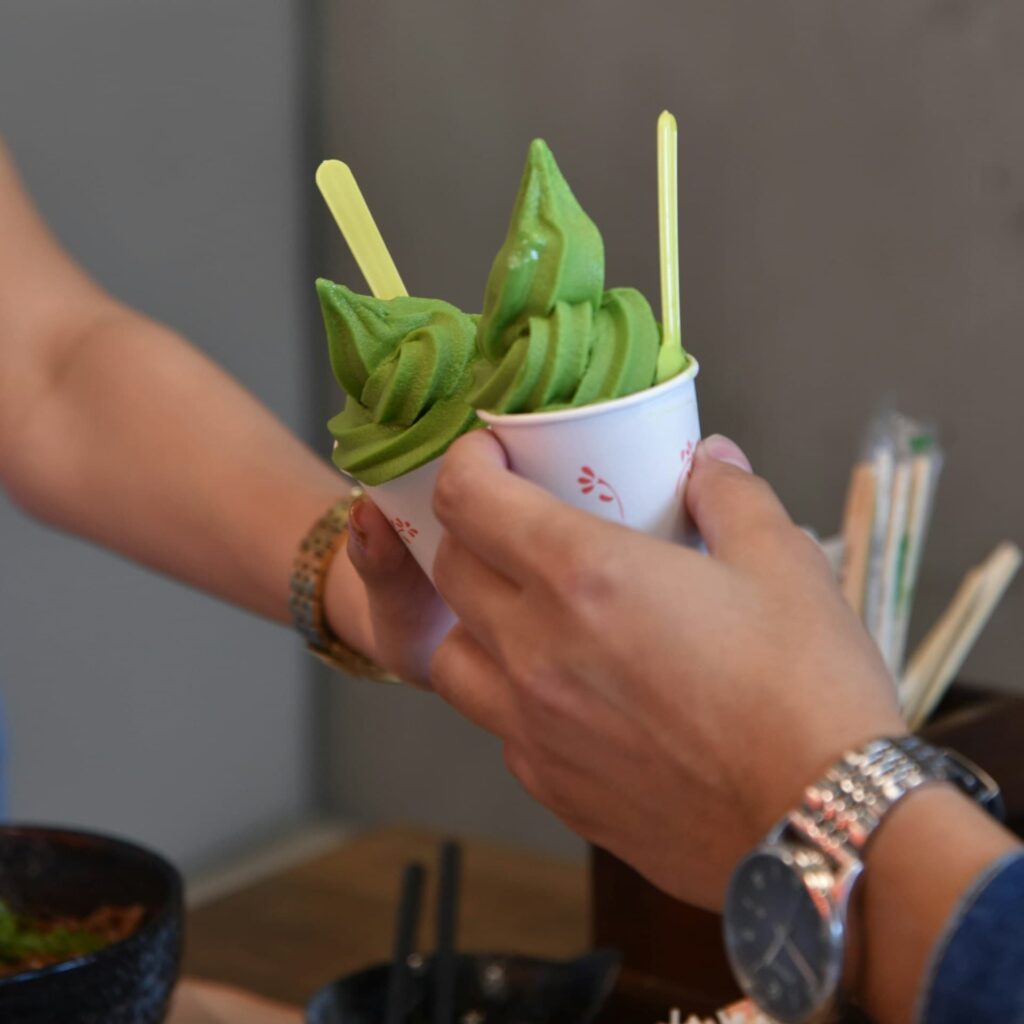
Matcha ice cream is a Japanese favorite that combines the earthy bitterness of matcha (green tea) with the creamy sweetness of ice cream. This popular dessert is enjoyed across Japan, often as a refreshing summer treat. Made with high-quality matcha powder, the vibrant green color and distinct flavor make it a unique and refreshing option.
🇯🇵 Variations of matcha ice cream
- Matcha soft serve: Creamier and lighter, served as a soft-serve ice cream.
- Matcha with red bean and mochi: Topped with azuki red bean paste and chewy mochi for extra texture and flavor.
- Hojicha ice cream: Made with roasted green tea for a more subtle, earthy taste.
💡 Interesting facts about matcha ice cream
- Matcha ice cream is considered a healthier choice among Japanese ice cream flavors because matcha is packed with antioxidants.
- Matcha ice cream is commonly served in parfaits alongside mochi, red bean paste, wafers, and even gold leaf.
- Some high-end matcha ice creams in Japan use ceremonial-grade matcha for an intense flavor.
🍽️ The proper way to eat matcha ice cream: Enjoy it slowly with a spoon, savoring the unique blend of bitter matcha and sweet creaminess. Pair with a few pieces of mochi for added texture.
Taiyaki
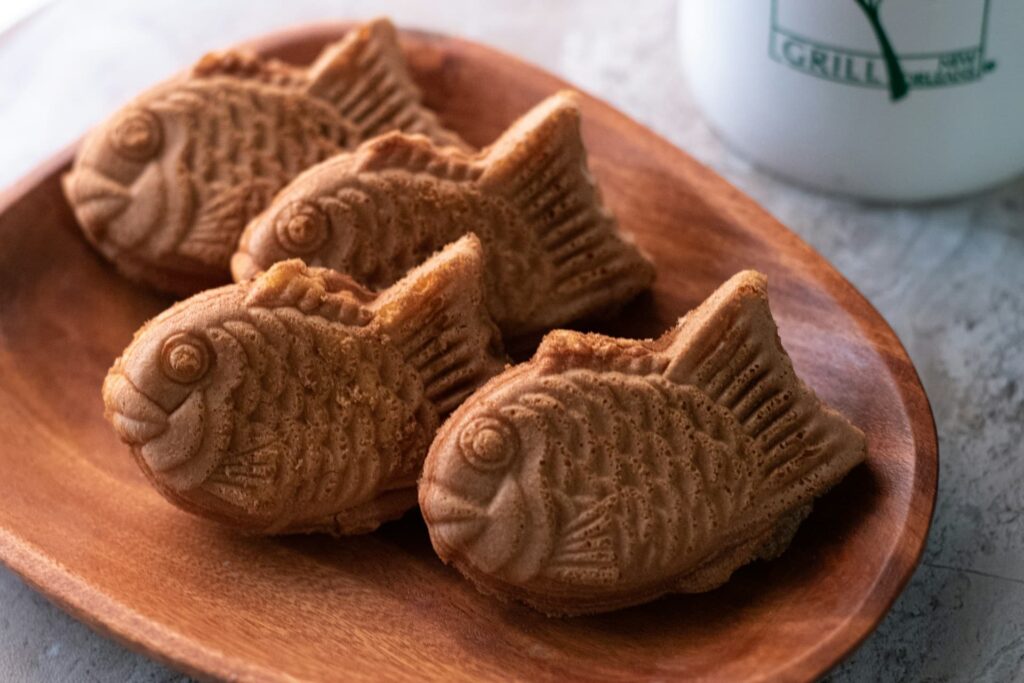
Taiyaki is a unique fish-shaped pastry filled with azuki red bean paste or other sweet fillings. Originally inspired by Western waffles and now a beloved symbol of Japanese food culture, this popular street food dessert is enjoyed across the country. The outer shell of taiyaki is crisp, while the filling is smooth and sweet, creating a delightful contrast in every bite.
🇯🇵 Variations of taiyaki
- Custard taiyaki: One of the most popular alternatives to red bean paste, offering a smoother and less earthy flavor.
- Chocolate taiyaki: Filled with chocolate (or chocolate cream), making it a favorite for kids and chocolate lovers alike.
- Sweet potato taiyaki: In autumn, taiyaki filled with mashed sweet potato (satsumaimo) is popular, bringing a seasonal, earthy sweetness to the classic snack.
💡 Interesting facts about taiyaki
- Taiyaki is believed to have originated in Tokyo in the early 1900s.
- The fish shape symbolizes good fortune in Japanese culture.
- Taiyaki can be found at festivals and street markets, making it a festive sweet treat.
🍽️ The proper way to eat taiyaki: Start by biting the head or tail first, depending on your preference! Each bite offers a balance of crispy exterior and warm, gooey filling.
Castella
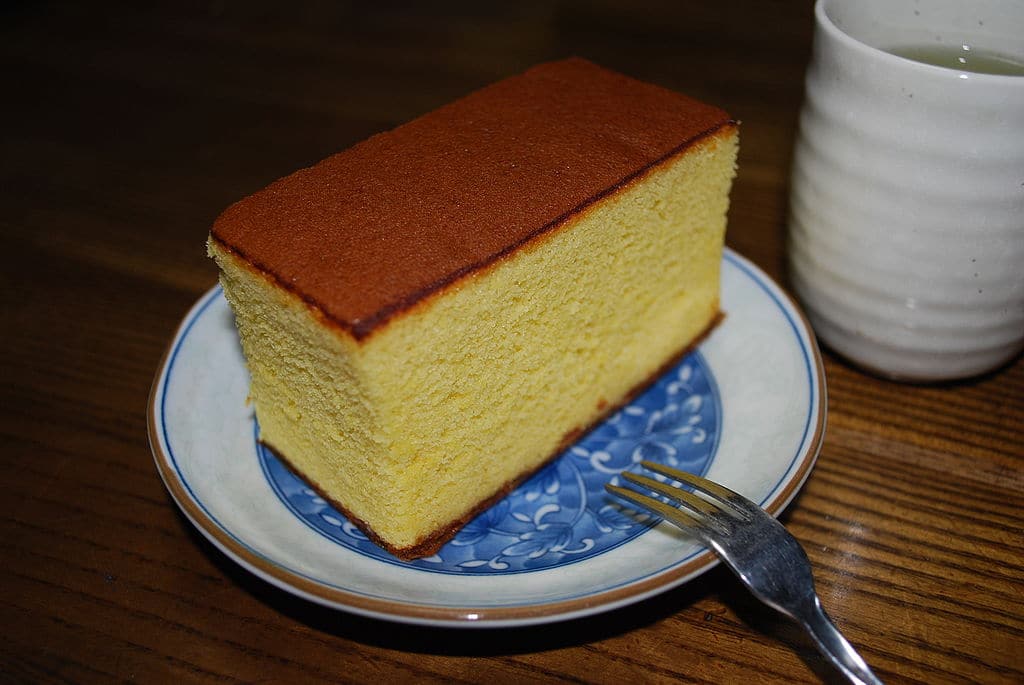
Castella cake, or “kasutera,” is a Japanese sponge cake with Portuguese origins, brought to Japan by missionaries in the 16th century. Made with simple ingredients like sugar, flour, eggs, and starch syrup, castella has a light, moist texture and a delicate sweetness. Unlike traditional sponge cakes, castella has no butter or oil, relying on beaten eggs for its soft, fluffy consistency. Popular in Nagasaki, where it was first introduced, castella has become a beloved Japanese dessert, often sold in rectangular loaves with a rich, caramelized top.
🇯🇵 Variations of castella cake
- Matcha castella: Infused with green tea powder for a subtle bitterness that complements the sweetness.
- Honey castella: Adds a hint of honey to the batter, creating a richer, more aromatic flavor.
- Chocolate castella: Flavored with cocoa powder, making it a favorite among younger generations.
💡 Interesting facts about castella cake
- Castella was introduced to Japan by Portuguese missionaries in the 16th century.
- Master bakers in Japan use techniques passed down through generations to create an even, moist, and delicate crumb without using leavening agents.
- Nagasaki is known as the birthplace of castella in Japan, with many shops specializing in the dessert.
🍽️ The proper way to eat castella cake: Slice the cake into small, even pieces to enjoy its light texture and sweetness. Pair with tea or coffee to enhance its flavors, and savor each bite to appreciate the caramelized top and soft, spongy interior.
About TourHero
TourHero is a social travel platform that enables you to travel with like-minded people and fall in love with the journey. We work closely with handpicked local operators to ensure every experience curated is unique and exclusive to your travel group. Come with us on epic adventures and create memories that last a lifetime. Get started here!
